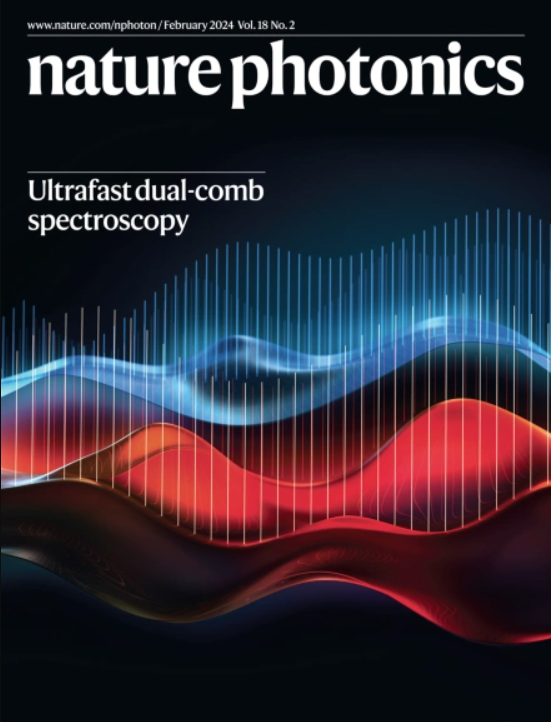High-power AlGaN deep-ultraviolet micro-light-emitting diode displays for maskless photolithography
IF 32.3
1区 物理与天体物理
Q1 OPTICS
引用次数: 0
Abstract
Developing aluminium gallium nitride deep-ultraviolet (UVC) micro-light-emitting diodes (micro-LEDs) with sufficient power has been a challenge, which particularly limits these devices to various applications. However, advanced fabrication processes have been developed to enable the demonstration of highly efficient 270 nm UVC micro-LEDs and large-format UVC micro-LED displays with high resolution for maskless photolithography. Optical and electrical characterizations were performed on UVC micro-LEDs with sizes ranging from 3 µm to 100 μm to evaluate these emerging devices. The 3 μm device achieved a record-high peak external quantum efficiency of 5.7% and a maximum brightness of 396 W cm–2. Moreover, 2,540 pixels per inch parallel-connected UVC micro-LED arrays featuring rear-side reflection layers exhibited emission uniformity and collimation. UVC micro-LED displays, with a resolution of 320 × 140, were explicitly designed for maskless photolithography applications utilizing a customized integrated circuit driver for optimal performance. The UVC micro-LEDs and UVC micro-displays provide sufficient doses to fully expose the photoresist film within seconds, owing to their enhanced current spreading uniformity, improved heat dispersion and superior light extraction efficiency. This work may open a path to maskless photolithography, potentially leading to revolutionary developments in the semiconductor industry. Deep-ultraviolet micro-light-emitting diodes based on aluminium gallium nitride are fabricated for maskless photolithography. The peak wavelength is 270 nm, and the 3 μm device achieved a peak external quantum efficiency of 5.7% and a maximum brightness of 396 W cm–2.


用于无掩膜光刻技术的高功率 AlGaN 深紫外微发光二极管显示器
开发具有足够功率的氮化镓铝深紫外(UVC)微型发光二极管(micro-LED)一直是一项挑战,这尤其限制了这些设备的各种应用。不过,先进的制造工艺已经开发出来,能够展示高效的 270 纳米 UVC 微型发光二极管和具有高分辨率的大尺寸 UVC 微型发光二极管显示器,适用于无掩模光刻技术。为评估这些新兴器件,对尺寸从 3 μm 到 100 μm 的 UVC 微型 LED 进行了光学和电学表征。3 μm 器件的峰值外部量子效率达到了创纪录的 5.7%,最大亮度为 396 W cm-2。此外,每英寸 2,540 像素平行连接的 UVC 微型 LED 阵列具有后侧反射层,显示出发射均匀性和准直性。UVC 微型 LED 显示屏的分辨率为 320 × 140,是专为无掩模光刻应用而设计的,利用定制的集成电路驱动器实现了最佳性能。由于 UVC 微型 LED 和 UVC 微型显示器具有更强的电流传播均匀性、更好的热分散性和更高的光萃取效率,因此能在几秒钟内提供足够的剂量使光刻胶薄膜完全曝光。这项研究为无掩模光刻技术开辟了一条道路,有可能为半导体行业带来革命性的发展。
本文章由计算机程序翻译,如有差异,请以英文原文为准。
求助全文
约1分钟内获得全文
求助全文
来源期刊

Nature Photonics
物理-光学
CiteScore
54.20
自引率
1.70%
发文量
158
审稿时长
12 months
期刊介绍:
Nature Photonics is a monthly journal dedicated to the scientific study and application of light, known as Photonics. It publishes top-quality, peer-reviewed research across all areas of light generation, manipulation, and detection.
The journal encompasses research into the fundamental properties of light and its interactions with matter, as well as the latest developments in optoelectronic devices and emerging photonics applications. Topics covered include lasers, LEDs, imaging, detectors, optoelectronic devices, quantum optics, biophotonics, optical data storage, spectroscopy, fiber optics, solar energy, displays, terahertz technology, nonlinear optics, plasmonics, nanophotonics, and X-rays.
In addition to research papers and review articles summarizing scientific findings in optoelectronics, Nature Photonics also features News and Views pieces and research highlights. It uniquely includes articles on the business aspects of the industry, such as technology commercialization and market analysis, offering a comprehensive perspective on the field.
 求助内容:
求助内容: 应助结果提醒方式:
应助结果提醒方式:


